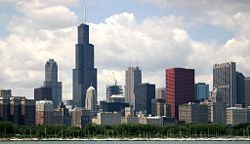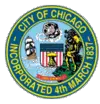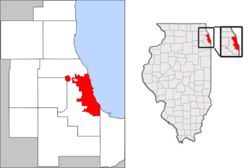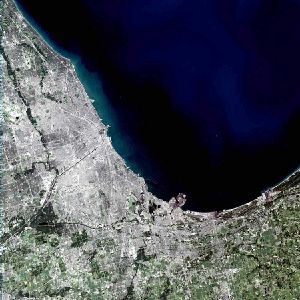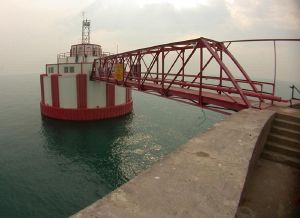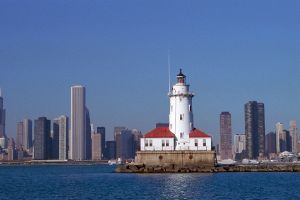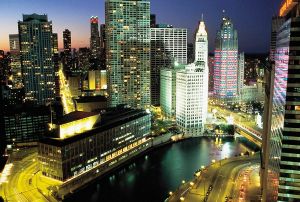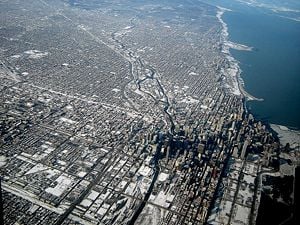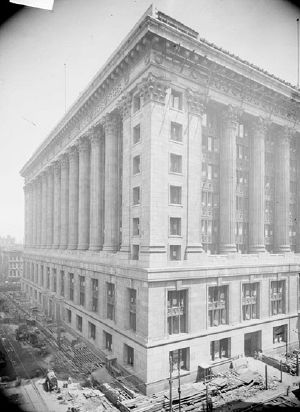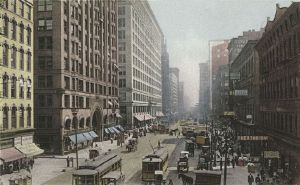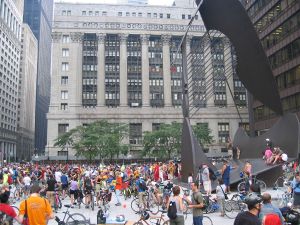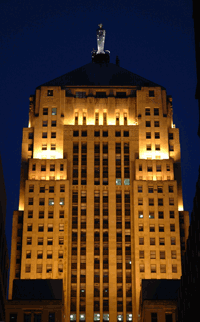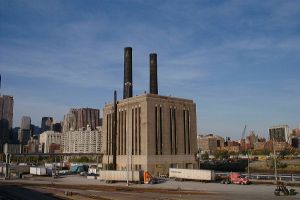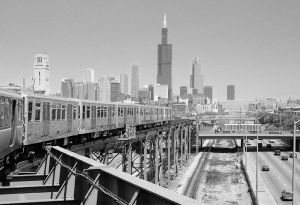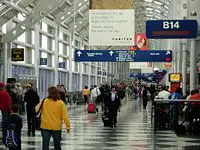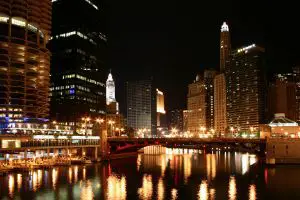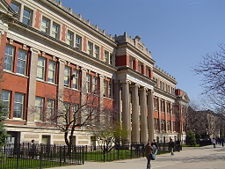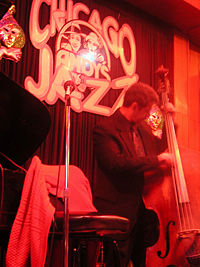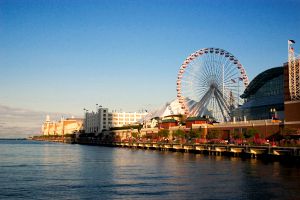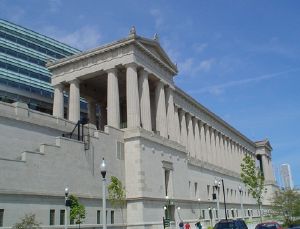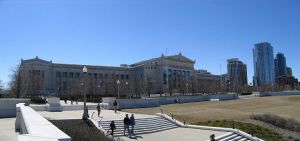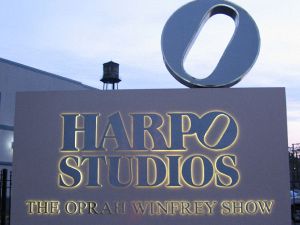| Chicago | |||
| ‚ÄĒ¬†¬†City¬†¬†‚ÄĒ | |||
|
|||
| Nickname: The Windy City, The Second City, Chi-Town, Hog Butcher for the World, City of Big Shoulders, The City That Works, White City, and others found at List of nicknames for Chicago | |||
| Motto: Latin: Urbs in Horto (City in a Garden), Make Big Plans (Make No Small Plans), I Will | |||
| Location in the Chicago metropolitan area and Illinois | |||
| Coordinates: {{#invoke:Coordinates|coord}}{{#coordinates:41|52|55|N|87|37|40|W|type:city | |||
|---|---|---|---|
| name= }} | |||
| Country | United States | ||
| State | Illinois | ||
| Counties | Cook, DuPage | ||
| Settled | 1770s | ||
| Incorporated | March 4, 1837 | ||
| Named for | shikaakwa ("Wild onion") |
||
| Government | |||
| ¬†-¬†Type | Mayor‚Äďcouncil | ||
|  - Mayor | Rahm Emanuel (D) | ||
| Area | |||
|  - City | 234.0 sq mi (606.1 km²) | ||
|  - Land | 227.2 sq mi (588.4 km²) | ||
|  - Water | 6.9 sq mi (17.9 km²)  3.0% | ||
|  - Urban | 2,122.8 sq mi (5,498 km²) | ||
|  - Metro | 10,874 sq mi (28,163.5 km²) | ||
| Elevation | 597 ft (182 m) | ||
| Population (2010 Census)[1][2] | |||
|  - City | 2,695,598 | ||
|  - Density | 11,864.4/sq mi (4,447.4/km²) | ||
|  - Urban | 8,711,000 | ||
|  - Metro | 9,461,105 | ||
| Time zone | CST (UTC‚ąí06:00) | ||
| ¬†-¬†Summer¬†(DST) | CDT (UTC‚ąí05:00) | ||
| Area code(s) | 312, 773, 872 | ||
| Website: cityofchicago.org | |||
Chicago is the largest city in the state of Illinois and the largest in the Midwest. With a population of nearly 3 million people, the city is the third largest in the United States. It is the anchor of the Chicago metropolitan area, commonly called Chicagoland, which has a population of over 9.7 million people in Illinois, Wisconsin, and Indiana, making it the third largest metropolitan area in the U.S.
Located at the site of a portage between the Great Lakes and the Mississippi River watershed, Chicago was incorporated as a city in 1837. It rapidly became a major transportation hub, as well as the business, financial, and cultural capital of the Midwest. In 1871, the city suffered a devastating fire which leveled much of the then sprawling metropolis.
The political environment in Chicago in the 1910s and 1920s allowed organized crime to flourish. Gangsters such as Al Capone and others brought international notoriety to the city. At the same time, Chicago made positive national contributions based upon its response to disasters. This included the first comprehensive sewer system in the nation following a fresh water crisis in the late 1800s, and standards for fire safety improvements to public and private schools following the disastrous Our Lady of the Angels School Fire in 1958.
In the mid-twentieth century, the city was the birthplace of Saul Alinsky's powerful grassroots social movement which spread throughout the nation and came to be known as "Community Organizing." Chicago is also well known as the inspiration of some of Carl Sandburg's most notable literary achievements.
Today the city's attractions bring 44.2 million visitors annually. Chicago was once the capital of the railroad industry and until the 1960s the world's largest meatpacking facilities were at the Union Stock Yards. The O'Hare International airport located southwest of the city is the second busiest airport in the world.
The city is a stronghold of the Democratic Party, and has been home to numerous influential American politicians.
Geography
Topography
Chicago is a midwestern city, located in northeastern Illinois at the southwestern tip of Lake Michigan. It sits on the continental divide at the site of the portage that connects the Mississippi River and the Great Lakes watersheds.
The city borders Lake Michigan, and two rivers‚ÄĒthe Chicago River in downtown and the Calumet River in the industrial far South Side‚ÄĒflow entirely or partially through Chicago. A canal connects the Chicago River with the Des Plaines River, which runs to the west of the city.
According to the U.S. Census Bureau, Chicago has a total area of 234.0 square miles (606.1 km²). The city is built on land that is quite flat. The average elevation is 579 feet (176 m) above sea level. The highest point, at 735 feet (224 m), is a landfill located on the city's far south side.
Climate
The city lies within the humid continental climate zone and experiences four distinct seasons. In July, the warmest month, high temperatures average 84.9¬†¬įF (29.4¬†¬įC) and low temperatures 65.8¬†¬įF (18.8¬†¬įC). In January, the coldest month, high temperatures average 31.5¬†¬įF (‚ąí0.3¬†¬įC) with low temperatures averaging 17.1¬†¬įF (‚ąí8.3¬†¬įC).
Chicago‚Äôs yearly precipitation averages about 34 inches. Summer is the rainiest season, with short-lived rainfall and thunderstorms more common than prolonged rainy periods. Winter is the driest season, with most of the precipitation falling as snow. The snowiest winter ever recorded in Chicago was 1929‚Äď1930, with 114.2 inches of snow in total.
Cityscape
Chicago's skyline is among the world's tallest. The three tallest buildings in the city are the Sears Tower (currently the tallest in the Western Hemisphere), the Aon Center, and the John Hancock Center. Future skyline plans entail the supertall Waterview Tower, Chicago Spire, and Trump International Hotel and Tower.
Large swaths of Chicago's residential areas away from the lake are characterized by bungalows built either during the early twentieth century or after World War II.
Parks line Lake Shore Drive; a few of the more notable include Grant Park, Millennium Park, and Lincoln Park. Interspersed are 31 beaches in Chicago, the Lincoln Park Zoo, several bird sanctuaries, McCormick Place Convention Center, Navy Pier, Soldier Field, the Museum Campus, and the Jardine Water Purification Plant.
Neighborhoods
Chicago can be divided by the river and its branches into four main sections.
The downtown area is the main commercial and cultural section of the city and includes the city's tallest buildings. In recent years, downtown has become so popular that a high number of residents live there. The Loop, a section of downtown, was named for a circuit of cable cars and later for the elevated train Loop where practically all branches of the elevated and subway trains led.
The South Loop area contains a mixture of races and ethnicities, including Scottish and Irish, Chinese, African American, Italian, and Filipino. The Chicago Stock Yards put Chicago on the map and made it a major business city. Now the extreme South Loop area is industrial and commercial mixed with residential.
The city's North Side is the most densely populated residential section of the city. Much of the North Side reaped the benefits of an economic boom that began in the 1990s. For example, the area just north of the Chicago River and the Loop has undergone a transition from an abandoned warehouse district to an active commercial, residential, and entertainment hub, featuring the city's largest concentration of contemporary art galleries.
The South Side encompasses roughly 60 percent of the city's land area; however, with a higher ratio of single-family homes and large sections zoned for industry, it is less densely populated than the North Side.
The South Side has two of Chicago's largest public parks. Jackson Park, the site of the Museum of Science and Industry, stretches along the lakefront. Washington Park is being considered as the primary site of the Olympic Stadium for the 2016 Summer Olympics if Chicago wins the bid.
Some West Side neighborhoods, particularly Garfield Park and Lawndale, have socio-economic problems including urban decay and crime. Other West Side neighborhoods, especially those closer to downtown, have been experiencing a rise in property value.
West Side parks include Douglas Park, Garfield Park, and Humboldt Park. Garfield Park Conservatory houses one of the largest collections of tropical plants of any U.S. city.
History
The name Chicago is the French rendering of the Miami-Illinois name shikaakwa, meaning ‚Äúwild leek.‚ÄĚ It was initially applied to the river and later came to denote the site of the present city. The sound "Chicago" is the result of a French mis-transcription of the original sound.
People lived in the area at least 10,000 years ago. During the mid-eighteenth century the Chicago area was inhabited primarily by Potawatomis, who took the place of the Miami and Sauk and Fox people. The first settler in Chicago, Haitian Jean Baptiste Pointe du Sable, arrived in the 1770s, married a Potawatomi woman, and founded the area’s first trading post. In 1803 the United States Army built Fort Dearborn, which was destroyed in 1812 during the War of 1812 in what became known as the Fort Dearborn Massacre. After abandoning the besieged fort, a column of 148 soldiers, women, and children were attacked by a band of Potawatomi warriors who killed more than 50 and sold the survivors as slaves to the the British, who released them immediately. The Ottawa, Ojibwa, and Potawatomi later ceded the land to the United States in the Treaty of St. Louis of 1816. Most of the Native Americans in the region were victims of the U.S. policy of forced relocation in the 1830s.
On August 12, 1833, the Town of Chicago was organized with a population of 350, and within seven years it grew to a population of over 4,000. The City of Chicago was incorporated on March 4, 1837.
Fast growth
Chicago in its first century was one of the fastest growing cities in the world. Within the span of only forty years, its population grew from slightly under 30,000 to over 1 million by 1890. In the next forty years the population tripled to over 3 million.[3] By the close of the nineteenth century, Chicago was the fifth largest city in the world and the largest of the cities that had not existed at the dawn of the century.
Starting in 1848, the city became an important transportation center between the eastern and western United States. Chicago’s first railroad opened. The Illinois and Michigan Canal allowed steamboats and sailing ships on the Great Lakes to connect through Chicago to the Mississippi River. A flourishing economy brought many new residents from rural communities and Irish, Polish, Swedish, German, and numerous other immigrants. The city’s manufacturing and retail sectors dominated the Midwest and greatly influenced the American economy, with the Union Stock Yards dominating the meat packing trade.
After the Great Chicago Fire of 1871 destroyed a third of the city, including the entire central business district, Chicago experienced rapid rebuilding and growth. During Chicago's rebuilding period, the world's first skyscraper was constructed in 1885, using steel-skeleton construction. This was Chicago's Home Insurance Building, built in 1885 and demolished in 1931 to make way for the Field Building (now the LaSalle National Bank Building).
In 1893, Chicago hosted the World's Columbian Exposition on former marshland at the present location of Jackson Park. The Exposition drew 27.5 million visitors.
Labor and social unrest

The city was the site of labor conflicts and unrest during this period, which included the Haymarket Riot on May 4, 1886. Concern for social problems among Chicago’s lower classes led Jane Addams to be a co-founder of Hull House in 1889, the first of what were called settlement houses. Programs developed there became a model for the new field of social work. The city also invested in many large, well-landscaped municipal parks, which also included public sanitation facilities.
The 1920s brought notoriety to Chicago as gangsters, including the notorious Al Capone, battled each other and law enforcement on the city streets during the Prohibition era. The 1920s also saw a major expansion in industry. The availability of jobs attracted African Americans from the South, who arrived by the tens of thousands.
On December 2 1942, physicist Enrico Fermi conducted the world’s first controlled nuclear reaction at the University of Chicago as part of the top-secret Manhattan Project.
The old stockyards neighborhood of Chicago was the birthplace of America's twentieth century phenomenon known as "Community Organizing." Saul Alinsky, a native Chicagoan, pioneered a new face of political activism through his powerful grassroots social movement. After initial success in Chicago, Alinsky organized community-action groups in various cities throughout the nation.
Mayor Richard J. Daley was elected in 1955, in the era of so-called machine politics. Starting in the 1960s, many upper- and middle-class citizens started leaving the city for the suburbs, as was the case in many cities across the country, leaving impoverished neighborhoods in their wake. Since the 1990s, the city has undergone a revitalization where some lower-class neighborhoods were transformed into pricey neighborhoods.
The city hosted the tumultuous 1968 Democratic National Convention, which featured physical confrontations both inside and outside the convention hall, including full-scale police riots in city streets.
New priorities
In 1983, Harold Washington became the first African American to be elected as mayor. Washington’s term in office saw new attention given to poor and minority neighborhoods. His administration reduced the longtime dominance of city contracts and employment by ethnic whites. In 1986, Chicago enacted one of the nation's most tenant-friendly landlord-tenant ordinances.
Mayor Richard M. Daley, son of the late Richard J. Daley, was first elected in 1989. New projects during the younger Daley’s administration have made Chicago larger, more environmentally friendly, and more accessible.
Law and government
Chicago is the county seat of Cook County. The government of the City of Chicago is divided into executive and legislative branches. The mayor is elected for a term of four years. The mayor appoints commissioners and other officials who oversee the various departments. In addition to the mayor, Chicago's two other citywide elected officials are the clerk and the treasurer.
The City Council is the legislative branch and is made up of 50 aldermen, one elected from each ward in the city. The council enacts local ordinances and approves the city budget. Government priorities and activities are established in a budget ordinance usually adopted each November.
For much of the twentieth century, Chicago has been among the largest and most reliable Democratic strongholds in the United States, with Chicago's Democratic vote totals leading the state of Illinois to be "solid blue" in presidential elections since 1992. The citizens of Chicago have not elected a Republican mayor since 1927. The strength of the party in the city is partly a consequence of Illinois state politics, where the Republicans have come to represent rural and farm concerns, while the Democrats support urban issues such as Chicago's public school funding. Although Chicago includes less than 25 percent of the state's population, eight of Illinois' nineteen U.S. Representatives have part of the city in their districts.
Because of the dominance of the Democratic Party in Chicago, the Democratic primary vote held in the spring is generally more significant than the general elections in November.
Crime
Chicago has experienced a decline in overall crime since the 1990s. Murders in the city peaked first in 1974 and again in 1992. After adopting crime-fighting techniques recommended by the Los Angeles and New York City Police Departments in 2004, Chicago recorded the lowest number of total homicides since 1965. Chicago's homicide tally remained steady from 2005 through 2007, with 449, 452, and 435, respectively, and the overall crime rate in 2006 continued the downward trend that has taken place since the early 1990s.
Economy
Chicago has the third largest gross metropolitan product in the nation‚ÄĒapproximately $442 billion according to 2007 estimates.[4] The city has also been rated as having the most balanced economy in the United States, due to its high level of diversification. Chicago was named the fourth most important business center in the world in the MasterCard Worldwide Centers of Commerce Index. Additionally, the Chicago metropolitan area recorded the greatest number of new or expanded corporate facilities in the United States for five of the past six years. The Boeing Company, for example, relocated its corporate headquarters from Seattle to Chicago in 2001.
Chicago is a major financial center with the second largest central business district in the U.S. The city is the headquarters of the Federal Reserve Bank of Chicago (the Seventh District of the Federal Reserve). The city is also home to three major financial and futures exchanges, including the Chicago Stock Exchange, the Chicago Board Options Exchange (CBOE), and the Chicago Mercantile Exchange (the "Merc"), which includes the former Chicago Board of Trade (CBOT).
Chicago and the surrounding areas also house many major brokerage firms and insurance companies, such as Allstate Corporation. In addition, a study indicated that Chicago has the largest high-technology and information-technology industry employment in the United States.
Manufacturing (which includes chemicals, metals, machinery, and consumer electronics), printing and publishing, and food processing also play major roles in the city's economy. Nevertheless, much of the manufacturing occurs outside the city limits, especially since World War II. Several medical products and services companies are headquartered in the Chicago area, including Baxter International, Abbott Laboratories, and the Healthcare Financial Services division of General Electric.
Moreover, the construction of the Illinois and Michigan Canal, which helped move goods from the Great Lakes south on the Mississippi River, and of the railroads in the nineteenth century made the city a major transportation center in the United States. In the 1840s, Chicago became a major grain port, and in the 1850s and 1860s Chicago's pork and beef industry expanded. As the major meat companies grew in Chicago many, such as Armour, created global enterprises. Though the meatpacking industry currently plays a lesser role in the city's economy, Chicago continues to be a major transportation and distribution center.
The city is also a major convention destination; Chicago is third in the United States, behind Las Vegas and Orlando, as far as the number of conventions hosted annually. In addition, Chicago is home to eleven Fortune 500 companies, while the metropolitan area hosts an additional 21 Fortune 500 companies. Chicago also hosts 12 Fortune Global 500 companies and 17 Financial Times 500 companies. The city claims one Dow 30 company, aerospace giant Boeing. The city and its surrounding metropolitan area are also home to the second largest labor pool in the United States, with approximately 4.25 million workers.[5]
Transportation
Chicago is a major transportation hub in the United States. It is an important component in global distribution, as it is the third largest inter-modal port in the world after Hong Kong and Singapore. Additionally, it is the only city in North America in which six Class I railroads meet.
Chicago is one of the largest hubs of passenger rail service in the nation. Many Amtrak long distance services originate from Chicago's Union Station, providing connections to New York, Seattle, New Orleans, San Francisco, Los Angeles, and Washington, D.C.
Nine interstate highways run through Chicago and its suburbs. Segments that link to the city center are named after influential politicians, with four of them named after former U.S. presidents.
The Chicago Transit Authority (CTA) handles public transportation in Chicago and a few adjacent suburbs. The CTA operates an extensive network of buses and a rapid transit system known locally as the "El" (for "elevated"), with several lines, including service to Midway and O'Hare airports.
Chicago offers 100 miles of on-street bike lanes, 10,000 bike racks, and a state-of-the-art central bicycle commuter station in Millennium Park. In addition, trails dedicated to bikes exist throughout the city.
Chicago is served by Midway International Airport on the south side and O'Hare International Airport, one of the world's busiest airports, on the far northwest side. In 2005, O'Hare was the world's busiest airport by aircraft movements and the second busiest by total passenger traffic.[6] Both O'Hare and Midway are owned and operated by the City of Chicago.
Demographics
A 2008 estimate puts the city's population at 2,833,300, making it the third largest in the United States.[7] It is the anchor of the Chicago metropolitan area, commonly called Chicagoland, which has a population of over 9.7 million people in Illinois, Wisconsin and Indiana, making it the third largest metropolitan area in the U.S.[8]
As of the 2000 census, there were 2,896,016 people, 1,061,928 households, and 632,909 families residing within Chicago. More than half the population of the state of Illinois lives in the Chicago metropolitan area. The population density of the city itself was 12,750.3 people per square mile (4,923.0/km²). There were 1,152,868 housing units at an average density of 5,075.8 per square mile (1,959.8/km²).
The racial makeup of the city was 36.39 percent African American, 31.32 percent white, 26.02 percent Hispanic or Latino (of any race), 4.33 percent Asian and Pacific Islander, 1.64 percent from two or more races, 0.15 percent Native American, and 0.15 percent from other races.[9]
The median income for a household in the city was $38,625, and the median income for a family was $46,748. Living below the poverty line were 19.6 percent of the population and 16.6 percent of the families. Of the total population, 28.1 percent of those under the age of 18 and 15.5 percent of those 65 and older are living below the poverty line.
Ethnic communities
Chicago's largest ethnic community are of German origin. In 1900, one out of every four residents had either been born in Germany or had a parent born there.
Chicago also has a large Irish-American population on its South Side. Many of the city’s politicians have come from this population. There is also a substantial Italian American population. Chicago has the largest population of Swedish Americans of any city in the United States.
The majority of African Americans are located on Chicago’s South and West Sides. The Chicago metropolitan area has the second largest African American population, behind only New York City.
Poles in Chicago make up the largest ethnically Polish population outside of Warsaw, Poland, making it one of the most important centers of Polonia, a fact that the city celebrates every Labor Day weekend at the Taste of Polonia Festival in Jefferson Park. Chicago has one of the largest concentrations of Italian Americans in the United States, with 500,000 living in the metropolitan area. The city also has a large population of Bulgarians (about 150,000), Lithuanians, the second largest Serbian, and the third largest Greek population of any city in the world. Chicago has a large Romanian-American community with more than 100,000, as well as a large Assyrian population.
Chicago has the third-largest South Asian population in the United States. The Devon Avenue corridor on the north side is one of the largest South Asian neighborhoods/markets in North America. The city has the second-largest Puerto Rican population in the continental United States and the second largest Mexican population in the United States after Los Angeles. There are about 185,000 Arabs in Cook County with another 75,000 in the five surrounding counties. Chicago is the center of the Palestinian and Jordanian immigrant communities in the United States.
Religion
With many of the immigrants who make up Chicago's population having come from such predominantly Catholic countries as Ireland, Poland, Italy, and Mexico, about four in ten people in the Chicago metropolitan area are Catholics. Other religions represented are Protestantism, Islam, Judaism, Hinduism, and Buddhism. In addition to the city's one thousand plus Christian churches, Chicago has more than 50 synagogues and several dozen mosques. The headquarters of the Nation of Islam is in Chicago.
The city is the seat of the head of the Assyrian Church of the East, Mar Dinkha IV, the Evangelical Covenant Church, and the Evangelical Lutheran Church in America headquarters.
Education
Public schools
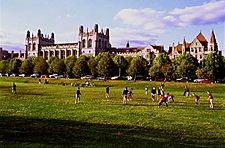
Chicago Public Schools (CPS) controls over 600 public elementary and high schools in Chicago. The school district has more than 400,000 students enrolled. The CPS includes several selective-admission magnet schools.
Like many urban U.S. school districts, Chicago Public Schools suffered many problems throughout the latter half of the twentieth century, including overcrowding, under-funding, mismanagement, and a high dropout rate. In 1987, then U.S. Secretary of Education William Bennett described the Chicago Public Schools as the "worst in the nation."[10] Several school reform initiatives have since been undertaken, including local school councils, charter schools, and efforts to end social promotion. The most notable and public of these reforms has been a concerted effort at aggressively closing down under-performing schools while at the same time renovating and improving successful ones or building new ones.
Private schools
The Roman Catholic Archdiocese of Chicago operates the city's Roman Catholic schools. Among the more well-known private schools in Chicago are the Latin School and Francis W. Parker School in the Lincoln Park neighborhood, as well as the University of Chicago Laboratory Schools in Hyde Park and the Ida Crown Jewish Academy in West Rogers Park.
Colleges and universities
Since the 1890s, Chicago has been a world center in higher education and research. One of the world's top research universities is located in Chicago: the University of Chicago in Hyde Park on the city's South Side. Another University of national prominence, Northwestern University, located in the northern suburb of Evanston, also has a campus downtown: the Feinberg School of Medicine and School of Law. Catholic universities are located in Chicago, such as DePaul University (the largest Catholic university in the U.S.), and Loyola University, which has one campus in the North Side and one in the downtown area, as well as a Medical Center in the western suburb of Maywood. Loyola University Chicago is the largest Jesuit Catholic university in the country. The Illinois Institute of Technology main campus in Bronzeville has renowned engineering and architecture programs and was host to world-famous modern architect Ludwig Mies van der Rohe for many years, and the IIT Stuart School of Business and Chicago-Kent College of Law are located downtown in the financial district.
The Chicago area has the largest concentration of seminaries and theological schools outside Vatican City, with the city itself home to the accredited institutions of Catholic Theological Union, Chicago Theological Seminary, Loyola Institute for Pastoral Studies, Lutheran School of Theology at Chicago, McCormick Theological Seminary, Meadville Lombard Theological School, North Park Theological Seminary, and the Divinity School of the University of Chicago, as well as the well-known conservative/fundamentalist Moody Bible Institute.
The University of Illinois at Chicago is the city's largest university and features the nation's largest medical school. Chicago State University and Northeastern Illinois University are other state universities in Chicago. The city also has a large community college system known as the City Colleges of Chicago.
The world-class School of the Art Institute of Chicago is well-known for fine arts programs. The Illinois Institute of Art Chicago is known for its applied arts programs. The American Academy of Art is known for its commercial art and fine arts programs. Columbia College Chicago is known for its performing arts and communications programs. Harrington College of Design is known for its interior design program.
Culture
Performing arts
Chicago‚Äôs theater community spawned modern improvisational comedy. Two renowned comedy troupes emerged‚ÄĒThe Second City and I.O. (formerly known as ImprovOlympic). Renowned Chicago theater companies include the Steppenwolf Theatre Company, the Goodman Theatre, and the Victory Gardens Theater. Chicago offers Broadway-style entertainment at several theaters.
Classical music offerings include the Chicago Symphony Orchestra, recognized as one of the finest in the world, which performs at Symphony Center. In the summer, many outdoor concerts are given in Grant Park and Millennium Park. The Civic Opera House is home to the Lyric Opera of Chicago.
The Joffrey Ballet and Chicago Festival Ballet perform in various venues, including the Harris Theater in Millenium Park. Chicago is home to several other modern and jazz dance troupes, such as the Hubbard Street Dance Chicago.
Other live music genres that are part of the city's cultural heritage include blues, soul, jazz, and gospel. The city is the birthplace of House Music and is the site of an influential hip-hop scene. In the 1980s, the city was a center for industrial, punk, and new wave. This influence continued into the alternative music of the 1990s. The city has been an epicenter for the rave culture since the 1980s. A flourishing independent rock music culture brought forth Chicago indie music.
Tourism
Chicago attracted 44.17 million people in 2006 from around the nation and worlds.[11] Upscale shopping along the Magnificent Mile, thousands of restaurants, as well as Chicago's eminent architecture, continue to draw tourists. The city is the United States' third-largest convention destination.
Navy Pier, 3,000 feet (900 m) long, houses retail stores, restaurants, museums, exhibition halls, and auditoriums. Its 150-foot (46 m) tall Ferris wheel is north of Grant Park on the lakefront and is one of the most visited landmarks in the Midwest, attracting about 8 million people annually.
In 1998, the city officially opened the Museum Campus, a 10-acre (4-ha) lakefront park surrounding three of the city's main museums: the Adler Planetarium, the Field Museum of Natural History, and the Shedd Aquarium. The Museum Campus joins the southern section of Grant Park, which includes the renowned Art Institute of Chicago.
The Oriental Institute, part of the University of Chicago, has an extensive collection of ancient Egyptian and Near Eastern archaeological artifacts. Other museums and galleries in Chicago are the Chicago History Museum, DuSable Museum of African-American History, Museum of Contemporary Art, and the Peggy Notebaert Nature Museum.
Sports
As of 2007, Chicago was the only North American city to have had champion teams in all five major sports, the big four plus soccer.
Chicago is home to two Major League Baseball teams: The Chicago Cubs of the National League play on the North Side in Wrigley Field. The Chicago White Sox, of the American League, play in U.S. Cellular Field on the city's South Side. The Chicago Bears football team is one of two charter NFL teams still in existence. The Bears have won nine total NFL Championships, the last occurring in Super Bowl XX. The Chicago Bulls of the NBA are one of the most recognized basketball teams in the world, thanks to the heroics of a player often cited as the best ever, Michael Jordan, who led the team to six NBA championships in eight seasons in the 1990s.
The Chicago Marathon has been held every October since 1977. This event is one of five World Marathon Majors.
Chicago hosted the 1959 Pan American Games. It was selected in 2007 to represent the United States internationally for the bid for the 2016 Summer Olympics.
Media
Chicago is the third-largest media market in North America (after New York City and Los Angeles). Each of the big four television networks directly owns and operates stations in Chicago. There are two major daily newspapers published in Chicago: The Chicago Tribune and the Chicago Sun-Times.
Looking to the future
Chicago faces the common problems of cities with large immigrant and minority populations: Overcrowded schools in need of repairs, lack of adequate affordable housing, drug use, gangs. There is wide income disparity between some sections of the city, and people tend to live in ethnic enclaves. As with all parts of the country, Chicago is affected by the general financial crisis facing the United States. It's possible that having a Chicagoan as president will draw attention (and funding) to the city.
In November 2008, Mayor Richard M. Daley received the final report of the 21st Century Commission, which he had created the previous year to review the fundamental scope and structure of city government. The report makes 64 recommendations in five broad categories: resident services for low and moderate income population; infrastructure investments; business services; environmental improvements; and internal operations.
"Whether in good economic times and bad, we're always looking for new and better ways to manage government, provide city services and protect taxpayers. We've embraced new management practices, emerging technology and out-of-the-box thinking to deliver more efficiently the services that our people demand and our taxpayers support," Daley said in a City Hall news conference.[12]
"In a changing world, you have to look ahead in order to stay ahead," the mayor said. "The basic question we must address is: Given our limited resources, how do we ‚Ķ assure that Chicago government continues to work for everyone‚Äďespecially our working families, the poor, and others who most need our support?" Daley said. One of the recommendations was creation of a new Department of Family and Support Services to improve the delivery of human services.[12]
Notes
- ‚ÜĎ U.S. Census Bureau Delivers Illinois' 2010 Census Population Totals, Including First Look at Race and Hispanic Origin Data for Legislative Redistricting. U.S. Census Bureau. Retrieved February 20, 2011.
- ‚ÜĎ Error on call to template:cite web: Parameters url and title must be specified. U.S. Census Bureau (March 2011).
- ‚ÜĎ University of Illinois at Chicago, Chicago Growth 1850-1990. Retrieved December 14, 2008.
- ‚ÜĎ The U.S. Conference of Mayors 74th Winter Meeting, January 13, 2006, U.S. metro areas are becoming even stronger engines of the U.S. economy, The United States Conference of Mayors.
- ‚ÜĎ CB Richard Ellis, Chicago Market Outlook 2006. Retrieved December 15, 2008.
- ‚ÜĎ Airports Council International, March 14, 2006, Preliminary Traffic Results for 2005 Show Firm Rebound. Retrieved December 15, 2008.
- ‚ÜĎ CNN Money, Best places to live. Retrieved December 15, 2008.
- ‚ÜĎ U.S. Census Bureau, December 30, 2003, Population in Metropolitan and Micropolitan Statistical Areas Ranked by 2000 Population for the United States and Puerto Rico.
- ‚ÜĎ U.S. Census Bureau, Chicago Demographics. Retrieved December 15, 2008.
- ‚ÜĎ New York Times, November 8, 1987, Schools in Chicago Are Called the Worst By Education Chief. Retrieved December 15, 2008.
- ‚ÜĎ Choose Chicago, Statistics. Retrieved December 15, 2008.
- ‚ÜĎ 12.0 12.1 City of Chicago, November 6, 2008, Daley Receives Final Recommendations of 21st Century Commission. Retrieved December 5, 2008
ReferencesISBN links support NWE through referral fees
- Grossman, James R., and Ann Durkin Keating, Janice L. Reiff. 2005. The Encyclopedia of Chicago. Chicago: University of Chicago Press. ISBN 0226310159.
- Madigan, Charles. 2004. Global Chicago. Champaign, IL: University of Illinois Press. ISBN 0252029410.
- Miller, Donald L. 1996. City of the Century: The Epic of Chicago and the Making of America. New York: Simon & Schuster. ISBN 0684801949.
- Nobleman, Marc Tyler. 2005. Chicago. Great Cities of the World series. Milwaukee, WI: World Almanac Library. ISBN 083685036X.
- U.S. Geological Survey. USGS‚ÄĒChicago. Retrieved December 12, 2008.
External links
All links retrieved December 9, 2023.
Credits
New World Encyclopedia writers and editors rewrote and completed the Wikipedia article in accordance with New World Encyclopedia standards. This article abides by terms of the Creative Commons CC-by-sa 3.0 License (CC-by-sa), which may be used and disseminated with proper attribution. Credit is due under the terms of this license that can reference both the New World Encyclopedia contributors and the selfless volunteer contributors of the Wikimedia Foundation. To cite this article click here for a list of acceptable citing formats.The history of earlier contributions by wikipedians is accessible to researchers here:
The history of this article since it was imported to New World Encyclopedia:
Note: Some restrictions may apply to use of individual images which are separately licensed.
